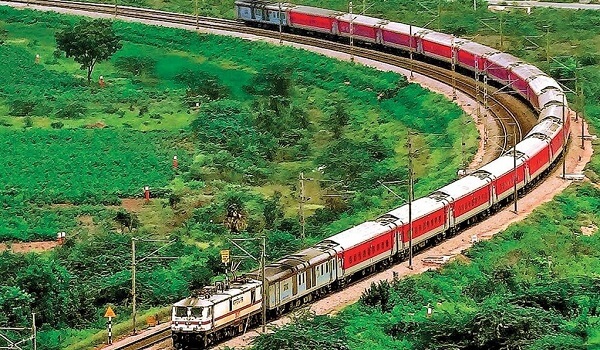Indian Railways is exploring the use of nuclear power through captive units as it seeks to increase reliance on non-fossil fuel sources and renewable ones. Apart from nuclear power, the Railways is already in the process of commissioning solar power units and wind-based power plants.
Nuclear Powered Trains
- A nuclear-powered train uses heat generated from a nuclear reaction to produce high-pressure steam.
- This steam drives two turbines, one turbine powers the train, while the other generates electricity for equipment like air conditioners and lights.
- The concept of nuclear-powered trains was first seriously considered in the 1950s, when it became an official goal of the USSR’s Ministry of Transport.
- Functioning of Nuclear-Powered Trains: The proposed design involves a portable nuclear reactor that heats fluid to produce steam. This steam drives electric turbines, generating power for the train.
- Safety Considerations: The use of thorium reactors is considered due to their relatively low radiation risk compared to other nuclear materials. The reactor’s design includes safety features to minimise risks and prevent misuse.
Potential Benefits
- Reduced Carbon Emissions: Nuclear power can significantly reduce CO2 emissions compared to fossil fuels, aligning with global efforts to combat climate change.
- Energy Efficiency: Nuclear reactors provide a high energy output with minimal fuel. This could potentially reduce the operational costs and environmental impact of rail transport over long distances.
- Low Infrastructure Requirements: Nuclear-powered trains could operate independently of overhead electric lines, reducing infrastructure costs and providing greater flexibility in operations.
- Extended Range: Nuclear-powered trains could operate over long distances without the need for frequent refuelling. This would be advantageous for freight and passenger services on extensive rail networks.
- High Efficiency: The potential for high operational efficiency is a major advantage. Nuclear reactors could provide continuous power, optimising rail transport performance.
Challenges of Nuclear-Powered Trains
- Radiation Risks: Handling nuclear materials and ensuring safety against radiation leaks are significant challenges. Adequate shielding and safety measures are essential to protect passengers and crew.
- High Costs: The initial costs for developing and implementing nuclear-powered trains are high. This includes the expense of developing small, safe reactors and integrating them into locomotives.
- Technical Complexity: Designing and maintaining nuclear reactors for moving trains involves complex engineering challenges.
Indian Railways Plans to Reduce its Reliance on Fossil Fuel Sources
- Nuclear Power Exploration: Discussions with the Nuclear Power Corporation of India (NPCIL) are planned to explore the use of nuclear power. Indian Railways is looking to have its own captive use power plants, small reactors, captive power generating units and so on.
- Net Zero Carbon Emission Target: The Railways plans to become a net zero carbon emitter by 2030. For it, IR will need 30,000 MW of renewable capacity by 2029-30.
- Current Renewable Energy Efforts: For use of renewables, the Railways is exploring partnerships with Solar Energy Corporation of India (SECI), NTPC, the Ministry of New and Renewable Energy (MNRE), among others.
- Renewable Energy Achievements: In 2023, about 147 MW of solar plants (both on rooftops and on land) and about 103 MW of wind power plants have been commissioned. Railways has electrified nearly 63,500 Kilometres till FY24, or over 96% of the total broad-gauge network. 2,637 stations and service buildings have been provided with solar roof-top plants with a total power generation capacity of 177 MW.
Indian Railways Need Alternative Sources of Energy
- High Energy Consumption: The Indian Railways consumes over 20 billion kWh of electricity annually, which is around 2% of the country’s total power consumption. This high level of consumption underscores the need for more sustainable energy solutions.
- Increasing Power Demand: Power requirements are projected to grow from 4,000 MW in 2012 to approximately 15,000 MW by 2032 due to ongoing electrification efforts. This substantial increase highlights the need for diversified energy sources.
- Electrification Targets: Indian Railways aims to electrify 100% of its broad-gauge network by 2030. This ambitious goal will significantly increase the demand for electricity, necessitating alternative energy sources to meet this need sustainably.
- Environmental Impact: The railway’s reliance on diesel and electricity results in high CO2 emissions. As a part of its low-carbon strategy, the Indian railways has envisaged a target of 33% reduction in its emissions intensity below 2005 levels by 2030. Diminishing Revenue Surplus: Railways’ revenue earnings have barely been able to keep up with its revenue expenditure. Between 2013-14 and 2023-24, Railways’ revenue expenditure is estimated to grow at an annualised rate of 7.2%, faster than its revenue receipts (annual growth of 6.3%). Indian Railways aims to generate its own energy to reduce its expenditure on outside energy sources.
- Cost Optimisation: Indian Railways is the largest consumer of electricity and spends close to Rs 20,000 crore annually to run their trains and offices. The organisation is looking to reduce costs through renewable energy procurement and lower-cost models for power generation.

